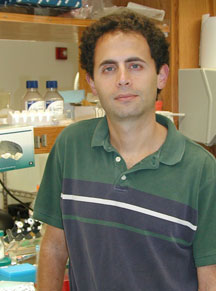

Enzyme Builds Neurotransmitters Via Newly Discovered Pathway
By Eric Sauter
Scientists at The Scripps Research Institute have uncovered a previously unknown function of an enzyme that appears to play a primary role in the biosynthesis of a large class of lipids that help modulate diverse physiological processes, including anxiety, inflammation, learning and memory, and appetite.
The study, which was directed by Scripps Research Professor Benjamin Cravatt is being published in the September 8 issue of The Journal of Biological Chemistry.
The new study describes a pathway—different than the one previously suggested—for the biosynthesis of neurotransmitter lipids, N-acyl ethanolamines (NAEs), which include the endogenous cannabinoid ("endocannabinoid") anandamide. The high activity of the enzyme a/b hydrolase4 (Abh4) in areas such as the central nervous system suggests that the pathway makes a "potentially major contribution" to endocannabinoid signaling.
Endocannabinoids are naturally produced substances similar to the active ingredient D9-tetrahydrocannabinol (THC) in marijuana. Cannabinoid receptors were first discovered in 1988; the first endocannabinoid, anandamide, which shares some of the pharmacologic properties of THC, was identified in 1992.
Other research has shown that the endogenous cannabinoid system helps control food intake, among other critical processes, by acting on cannabinoid receptors in the central nervous system. The system drives consumption of fat and calorie-rich foods and the amount of fat stored or expended and plays a significant role in energy homeostasis.
"At least one cannabinoid receptor antagonist is on the verge of approval for the treatment of obesity-metabolic disorders," said Cravatt. "Enzymes involved in endocannabinoid biosynthesis, such as the one highlighted in our study, can be viewed as complementary drug targets. One potential advantage of this approach is that it may prove more selective than a receptor antagonist. By inhibiting enzymes such as Abh4, we may be able to disrupt the activity of a single class of endocannabinoids, rather than all of them."
In the new study, the researchers provide biochemical evidence of an alternative pathway for NAE biosynthesis in vivo and demonstrate that these new routes are especially important for the creation of a number of NAEs, including anandamide. The researchers also isolated and identified the enzyme Abh4 by combining traditional protein purification and functional proteomic technologies, concluding that Abh4 "displayed multiple properties" that would be expected of an enzyme involved in NAE biosynthesis.
However, the authors of the study noted, the unique contribution that this Abh4-mediated route makes to the production of NAEs in vivo is yet to be determined and will require "the generation of genetic or pharmacological tools that selectively [interrupt] this pathway."
"The continued pursuit of additional enzymes involved in NAE biosynthesis should further enrich our understanding of the complex metabolic network that supports the endocannabinoid/NAE system in vivo," Cravatt said. "From a therapeutic perspective, any of these enzymes could represent an attractive drug target for a range of human disorders in which disruption of endocannabinoid signaling by cannabinoid receptor antagonists has proven beneficial."
Gabriel Simon of Scripps Research was the other author of the study, titled "Endocannabinoid biosynthesis proceeding through Glycerophospho-N-Acyl ethanolamine and a role for a/b hydrolase 4 in this pathway."
The research was supported by the National Institutes of Health, the Skaggs Institute for
Chemical Biology, and the Helen L. Dorris Institute for the Study of Neurological and Psychiatric Disorders of Children and Adolescents.
Send comments to: mikaono[at]scripps.edu

"Enzymes involved in endocannabinoid biosynthesis, such as the one highlighted in our study, can be viewed as complementary drug targets," says Professor Benjamin Cravatt.
